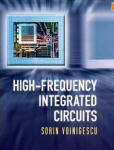Answers to High-Frequency Integrated Circuits
|
|
Click here for the complete list of RF Cafe Quizzes. Note: Some material based on books have quoted passages. This quiz is based on the information presented in High-Frequency Integrated Circuits, by Rosin Voinigescu. Cambridge University Press graciously provided this book.
Return
to
1. Why are S-parameters preferred for high frequency network analysis? b) Open and short circuit terminations are not required True open and short circuit terminations, which are required for Y-, Z-, h-, and G-parameters, are difficult to achieve at high frequencies, but S-parameters use easily produced impedance values such as the standard 50 Ω and 75 Ω. (see page 82)
2. To what temperature is noise figure normally referenced? d) 290 K Friis suggested that the noise figure (factor) be defined wrt a reference temperature of 290 K. (see page 107)
3. Where does the Quantum Confinement (QC) effect occur in a MOSFET? b) At the gate QC occurs in the quasi-triangular potential well formed in the inversion layer at the channel-gate dielectric interface. (see page 176)
4. Why is substrate resistance important? d) It degrades fMAX and FMIN The substrate resistance is important in high-frequency and high-speed applications because it degrades fMAX and FMIN. (see page 191)
5. At what rate has MOSFET gate shrink scaling factor (√2) occurred since the 1970s? b) Every 2-3 years Ever since the first commercial LSI CMOS circuits appeared in the early 1970s, the minimum feature size ofCMOS technology, usually represented by the physical gate length of the MOSFET, has shrunk by a factor S = √2 every 2-3 years. (see page 209)
6. Who developed the first High Electron Mobility Transistor (HEMT)? c) Fujitsu (Japan) The first HEMT was fabricated by Fujitsu, in Japan, in 1980. (see page 254)
7. When is coplanar waveguide (CPW) more desirable than microstrip on a semiconductor substrate? c) When a ground plane located on the top of the IC is not feasible. In situations where a ground plane on top of the semiconductor wafer is not feasible or has high loss, CPW can have (significantly) lower loss than microstrip lines realized directly over the silicon substrate. (see page 301)
8. What is the definition of Power Added Efficiency (PAE) of a power amplifier? d) (POUT - PIN) / PDC PAE is the ratio of the difference in input and output signal power and the DC supply input power. (see page 375)
9. What is the best type of biasing for an Low Noise Amplifier (LNA) at high temperature? d) Complimentary to Absolute Temperature (CTAT) current mirror bias Peak gain current density does not change with temperature; therefore, PTAT is not very effective whereas CTAT should be used. (see page 488)
10. How are in-phase (I) and quadrature (Q) components of an RF signal generated? a) With a 90° (hybrid quadrature) equal amplitude power coupler The hybrid quadrature coupler uses an effective 1/4-wavelength additional length in one signal path (usually 3 dB down = equal amplitude split) to create I (0°) and Q (90°) output signal ports. (see page 608)
Posted October 17, 2019 (original 5/23/2013) |

